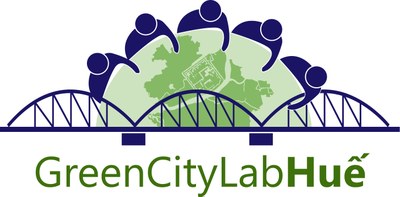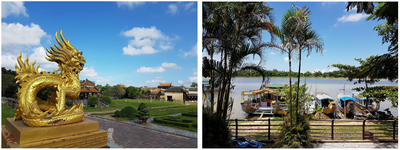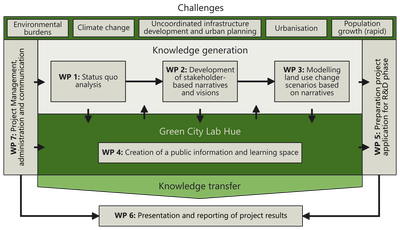GreenCityLabHue: Nature-based solutions to strengthen climate resilience of urban regions in Central Vietnam

Global warming and urbanisation are closely interconnected. Cities are both drivers of global warming and especially affected by its impacts. The need for climate mitigation and adaptation as well as building resilience is therefore becoming essential for urban policy. In this context, nature-based solutions (NBS) in urban and regional planning are gaining increasing importance. NBS refer to the sustainable management and use of nature for tackling environmental and societal challenges such as climate change and the urban heat island effect, water supply security, water and air pollution, food security, human health, and disaster risk management. They include the enhancement and expansion of green-blue infrastructure (GBI), a strategically planned network of natural and semi-natural areas with other environmental features, designed and managed to deliver a wide range of ecosystem services. GBI planning also helps to reduce dependence on 'grey' (built) infrastructure that is often more expensive to build and maintain. It is therefore a smart investment for cities, especially in developing countries.
Background
Vietnam is one of the most densely populated countries in the world with a population of about 95 million, living in an area of only 331,221 km2. In addition, with an urbanisation rate of 3.4% per year, Vietnam is undergoing a fast-moving urbanisation process, affecting besides Hanoi and Ho Chi Minh City also secondary cities such as Hai Phong, Da Nang, Can Tho, and Hue. The current share of urban population of over 30% across the nation will grow to a share of over 50% by 2025 (Anh et al. 2013). Moreover, Vietnam is one of the countries hit hardest by climate change impacts (Kreft et al. 2015). Due to its exposed geographical location, Central Vietnam, where the city of Hue is located, suffers regularly from storms, heavy rainfall events and extreme heat waves (UNDP 2008). The outcome of such extreme weather events are often heavy infrastructure damages and casualties (Dang et al. 2016). A strategy is needed to develop Vietnam’s cities in a sustainable and climate resilient manner. However, coherent proactive urban development plans for Vietnamese cities, that consider the urbanisation processes and climate change impacts, are currently missing.
In the Central Vietnamese city of Hue a step in this direction was taken with the Hue GrEEEn City Action Plan, developed by the Asian Development Bank. Although it includes actions on blue infrastructure or GBI, e.g. the rehabilitation of ponds and canals as well as the introduction and promotion of low impact development (ADB 2015), a more holistic picture of GBI, which takes the Greater Hue area and climate change mitigation and adaptation into account, is missing.
Its prominent position as official 'grade 1 – top priority city' within the Vietnamese Government’s city rating system and its outstanding historic and educational importance give the city of Hue the status of a role model for the more than 65 other provincial capital cities. The combination of its high exposure to climate change impacts, its relatively young and well-educated population, and its touristic importance make Hue an ideal location for an Urban Learning Lab (ULL) for innovative, participatory and thus suitable concepts of GBI and urban climate change mitigation and adaptation.

Figure 1: Green-blue infrastructure in Hue (left: park citadel of the city of Hue; right: riverbank Perfume River in Hue) (Source: Fabian Stolpe).
Main objectives
The aim of the project GreenCityLabHue is to create a multi-level, multi-disciplinary space for research and experimentation to develop, visualize, evaluate and discuss ideas and concepts for the (re-)creation and expansion of GBI in the city of Hue, Central Vietnam. In cooperation with stakeholders from science, administration, politics and the civil society, and under consideration of existing urban development plans, the project consortium develops shared expertise, common concepts and a database to facilitate the coordinated, strategic development of a network of (semi-)natural areas across the city of Hue. Integrating NBS and GBI into Hue’s city planning may help to protect various ecosystem services, thereby increasing the social and ecological resilience of the city of Hue and its surrounding region, e.g., regarding climate change impacts. The project explicitly aims at:
- acquiring and providing information on existing and potential GBI
- developing land use scenarios based on narratives and visions of stakeholders,
- supporting participatory processes, capacity-building, co-learning and co-creation,
- inspiring other Vietnamese cities to improve climate resilience, and
- providing the basis for the subsequent research and development project.
Structure and Tasks
The collaborative project is divided into seven work packages (WP). All WPs are content-related, interlinked operatively, in constant exchange and contribute to the development of the 'Green City Lab' and the basis for the subsequent research and development project. The different WPs are focusing on the following subjects:
WP1: Analysis of the status quo of GBI in Hue by carrying out a desk research, conducting stakeholder interviews and an inventory of natural urban spaces that have a potential for GBI and ecosystem services and its assessment using GIS data classification.
WP2: Development of stakeholder-based narratives and visions in a stakeholder workshop and their subsequent translation into computational rules (codes) for modelling land use change in GIS.
WP3: Modelling land use change scenarios based on the narratives by simulating land use changes of a test case scenario using (i) a multilayer GIS model and (ii) a cellular automaton model in the definition phase, mapping future land use change or persistency, and quantifying selected ecosystem services provided by GBI.
WP 4: Creation of a public information and learning space (Green City Lab) and the GreenCityLabHue project website that will serve as a learning and information space and as main tool for the external project communication, both in Germany and Vietnam.
WP5: Preparation of the project application for the main research project (R&D phase), by identifying key research questions and developing an implementation plan for the main project (R&D phase).
WP6: Presentation and reporting of project results at the closing event in Hue and by producing a trilingual final project report.
WP7: Project Management, administration and communication

Figure 2: Structure of the research project and the associated work packages (© GreenCityLabHue project).
Institutions and entities involved in the GreenCityLabHue project can be divided into three groups (extended project consortium, Vietnamese project partners and information partners) regarding the intensity of their involvement and their responsibilities in the project.

Abbildung 3: Struktur des GreenCityLabHue-Projektnetzwerks mit dem Projektkonsortium bestehend aus den deutschen Partnern HUB und UfU und dem erweiterten Projektkonsortium inklusive des vietnamesischen Unterauftragnehmer MISR (© GreenCityLabHue project).
The extended project consortium consists of the Geography Department of the Humboldt-Universität zu Berlin (HUB), the Independent Institute for Environmental Issues (UfU) from Berlin and the Mientrung Institute for Scientific Research (MISR) from Hue, Vietnam, which is sub-contracted. The project consortium is responsible for the implementation of the WPs, whereby the associated partners perform different tasks. Further Vietnamese project partners such as the DONRE (Regional Environmental Authority) of Thua Thien Hue Province, the DPI (Department of Planning and Investment), the Department for Climate Change of Hue University of Agriculture and Forestry (HUAF) and the Faculty of Architecture of Hue University of Science (HUSC) are directly linked to the GreenCityLabHue project. They participate in project workshops and the major project meetings in Hue., Besides other stakeholders, they serve as interview partners and are responsible for the collection of data onsite. They support the project with their data, knowledge and development visions to the central project database, and also have direct access to it. Furthermore, information partners are persons and organisations with important influence and knowledge on local urban development. They contribute to the development of the database by sharing their ideas, information and visions without being direct project partners.
Independent Institute for Environmental Issues in GreenCityLabHue
Within the collaborative research project, UfU leads the work package on the creating of a public information and learning space, the so called “Green City Lab” as well as the design, the conduction and evaluation of stakeholder interviews. In addition, UfU focuses on the involvement of suitable individuals and stakeholder from civil society, scientific institutions, politics and administration in Vietnam and the internal and external communication with the project partners and the public in Germany and Vietnam. Moreover, the coordination and supervision of the project activities and events are among the UfU tasks.
Contact:
Fabian Stolpe
Unabhängiges Institut für Umweltfragen - UfU e.V.
Greifswalder Str. 4
10405 Berlin
Tel.: +49 [30] 4284 993 33
Fax: +49 [30] 4280 04 85
fabian.stolpe@ufu.de
Humboldt-Universität zu Berlin in the GreenCityLabHue project
Besides the scientific monitoring, HUB, as a specialist for land use modelling, GBI and NBS, takes lead in the work package dedicated towards the development of stakeholder-based narratives and visions regarding GBI and the modelling of land use change scenarios based on the narratives. The objective of the definition phase is to develop knowledge-intensive narratives in collaboration with local stakeholders, experts and practitioners, taking into account the inventory of natural urban spaces and their potential for GBI, the findings of the stakeholder interviews and achieving a number of targets for previously defined goals (climate change adaptation, health, flooding etc.). Then to translate the narratives into computational rules (codes) for modelling land use change in GIS and to simulate land use change in a test scenario and to generate maps to visualise changes. Additionally, HUB illustrates benefits of GBI and NBS, particularly with climate change adaptation and flooding. This includes the presentation of case studies in which GBI and NBS have been successfully implemented, and the integration of measures to establish GBI and NBS into the development of stakeholder-based narratives, to demonstrate their positive effects.
Contact:
Prof. Dr. Dagmar Haase
Mathematisch-Naturwissenschaftliche Fakultät
Geographisches Institut
Landschaftsökologie
Unter den Linden 6
10099 Berlin
Tel.: +49 [30] 2093 9445
Fax: +49 [30] 2093 6848
dagmar.haase@geo.hu-berlin.de
M.Sc. Jessica Jache
Mathematisch-Naturwissenschaftliche Fakultät
Geographisches Institut
Landschaftsökologie
Unter den Linden 6
10099 Berlin
Tel.: +49 [30] 2093 6893
Fax: +49 [30] 2093 6848
jessica.jache@geo.hu-berlin.de
Relevance to framework programme and expected deliverables
The project creates a space for the exchange of information, data and ideas on GBI in Hue between stakeholders from science, administration, politics and civil society; and to experiment with different urban development scenarios. This international and multidisciplinary cooperation translates approaches and ideas of sustainable urban development into specific options for action and makes possible changes visible for local stakeholders and the wider public. This allows not only the development of widely accepted, realistic and thought-out activities to improve socio-ecologic conditions, climate-change mitigation and resilience in Greater Hue. It also strengthens the capacities of Hue’s administrative-political decision-makers in translating general urban development guidelines into practical and suitable measures and outputs by working together with scientists, citizens and civil society representatives. Hue can serve as a model to transfer the described approaches to other decentrally governed, fast-growing and climate-prone cities in Vietnam.
The project will encourage the restoration and expansion of GBI, including natural spaces such as urban parks, green walls, green roofs, habitat networks, and water, in Hue. These provide a number of environmental and social benefits: Besides stimulating positive effects on climate change mitigation and adaptation in the urban area of Hue, the project will also induce positive effects on the health and the quality of life of its citizens and its status as a tourist destination. Furthermore, the project will stimulate a more efficient management of adverse impacts of climate change such as floods and heat waves and other natural hazards. Additionally, the project will create a learning space for information, education and discussion on green and sustainable urban development in Hue and Vietnam. The 'Green City Lab' will serve as a database and permanent place of exchange and work for the main research project. The established network can be used by local decision-makers, experts and civil society as the basis for prioritising and managing the implementation of measures to promote GBI, even after the project ends. In addition, the project contributes to more participatory and interdisciplinary approaches in urban planning by raising awareness and providing participation opportunities for civil society.
Literature
Anh, T. T., Phong, T. V. G., Tuan, T. H., & Mulenga, M. (2013): Community consultation for long-term climate-resilient housing in Vietnamese cities: a comparative case study between Hue and Da Nang. Asian Cities Climate Resilience, IIED.
Asian Development Bank (ADB) (2015): Hue GrEEEn City Action Plan: Main report. Online: https://www.adb.org/sites/default/files/publication/179170/hue-greeen-city-ap.pdf.
Dang, T. N., Seposo, X. T., Duc, N. H. C., Thang, T. B., An, D. D., Hang, L. T. M., & Honda, Y. (2016): Characterizing the relationship between temperature and mortality in tropical and subtropical cities: a distributed lag non-linear model analysis in Hue, Viet Nam, 2009–2013. Global health action, 9(1), 28738.
Kreft, S., Eckstein, D., Junghans, L., Kerestan, C. and Hagen, U. (2015): Global Climate Risk Index 2015. Who Suffers Most From Extreme Weather Events? Briefing Paper. Germanwatch 2015.
UNDP (2008): Climate Change and Human Development in Vietnam, UNDP Human Development report 2007/2008. Online: http://hdr.undp.org/sites/default/files/chaudhry_peter_and_ruysschaert_greet.pdf.
Funding and Duration
Project funder
German Federal Ministry for Education and Research (BMBF), Germany
Project management agency
German Aerospace Center (DLR), Germany
Project duration
July 2019 to December 2020
Funding code
01LE1910
Research and development projects in the area of "Sustainable development of urban regions"

